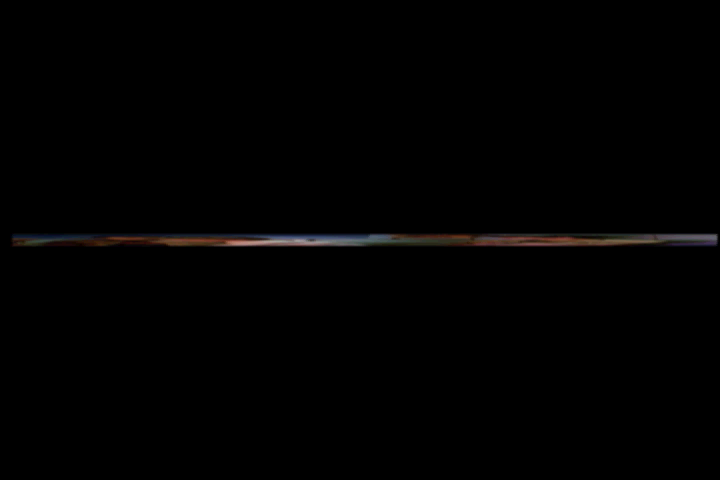
16 x 16 Candles, screenshot, (2006)
Transformer Fire (2008) originated online and was then translated to the gallery space for a show at artMovingProjects in Brooklyn. It generated a lot of interest in a past Rhizome blog post. Can you discuss this process of transforming a net art piece into the gallery space?
The Transformer Fire videos were originally posted on a group blog called Spirit Surfers, and the format of the blog limits the size, presentation, and bandwidth. So when I was preparing the video for the show, I optimized it for the screen that Aron would be using, rendering the videos in higher quality and in portrait orientation for a sideways monitor to better fit the vertically oriented stack of 5 videos, and I matched the resolution of the video to the monitor so I could control exactly how things were scaled. The presentation was a bit cleaner and clearer than on the blog.
Your interest in making music led you to design an iPhone music sampler app, and then an app that is an artwork and a musical instrument. Do you follow the development of art apps? Do you think it could become a new distribution channel for art?
I've looked at some art apps, but personally I think games are the best art in the App Store. I think Cookie Dozer Thanksgiving is more visually and mechanically interesting than any art app I've seen. Maybe I'm missing the best art apps because I don't know how to find them. I think that I would be more inclined to say that apps could become a new medium for art rather than a channel. I can't think of a lot of existing art that could be distributed and viewed properly with an iPhone or even iPad.
A number of your works, like 16 x 16 Candles and You’re Not My Father, or the Atari-based works use the shift from the aesthetic of pop culture or games to create a different aesthetic, of net and gallery-based art. Can you talk a little bit about this and about your affinity with the aesthetics of 1980s video games especially?
I like Atari 2600 games partly because that is the first game system I had, and I always wanted to make games for it. But I also love the way the graphics are so abstracted due to the machine limitations, and working with machines like this turns graphics programming into this unusual puzzle that is a catalyst for creativity.

Age:
36.
Location:
Flatbush, NY.
How long have you been working creatively with technology? How did you start?
When I was in elementary school, I took a summer class for kids to learn Logo graphics programming on the Texas Instruments 99/4a computer. I loved making and programming graphics, and continued to program whenever I had access to a computer. Later on, when I got a Commodore 64, I continued creating simple art-like graphics and music programs, and later incorporated this software into bands that I played with. In the late 80s, I got one of my abstract graphics programs published in 3-2-1 Contact magazine and they paid me $25.
Describe your experience with the tools you use. How did you start using them?
Most of my tools are software and I've used many different kinds. I use a lot of compilers and assemblers for different languages and platforms. For programming iPhone apps I use Apple's XCode. For image editing I use GIMP instead of Photoshop, although I'm considering getting Photoshop because GIMP is really far behind. For video editing I use an open source script-based editor called AVISynth.
Where did you go to school? What did you study?
I have a bachelor’s degree in computer science from University of Texas at Dallas, which is a tech-oriented school.
What traditional media do you use, if any? Do you think your work with traditional media relates to your work with technology?
I painted a little in college, and I produce prints. Some of my prints are arguably a kind of photography. I think the traditional thing that contributes the most to my new media artwork is my music.
There is a lot of crossover.
Are you involved in other creative or social activities (i.e. music, writing, activism, community organizing)?
I play music using the apps that I've been building, which is currently my creative focus. I have written a few essays about art and music. And/Or, the gallery I ran, was essentially a lot of community organizing, but I don't do anything like that now.
What do you do for a living or what occupations have you held previously? Do you think this work relates to your art practice in a significant way?
Most of my work has been different kinds of embedded systems programming jobs, which is programming work on devices other than desktop computers or laptops: like the iPhone, a handheld inventory scanner, an Atari 2600, a printer, etc. Since much of my artwork and music involve programming, I use a lot of the same skills at work and in my artwork. I also have sometimes earned part of my living doing commercial music, which is primarily how I supported the gallery.
Who are your key artistic influences?
Some big-time artists I really admire are Duchamp, Mike Judge, and Ariel Pink. Kevin Bewersdorf, Guthrie Lonergan, and Cory Arcangel are some of my most direct influences.
Have you collaborated with anyone in the art community on a project? With whom, and on what?
I've done quite a few collaborations. One of my favorites is when I worked with Mike Smith to restore an arcade game that he made in the mid-80s called "Mike Builds a Shelter." The game was a custom-built cabinet with a TV and a Commodore 64. We had the cabinet rebuilt and artwork recreated, and I restored the game from some old disks and source code.
http://www.fluentcollab.org/mbg/index.php/reviews/review/107/62
Do you actively study art history?
I've spent some time studying it in the past, but I never studied it in school. At times I've considered getting some kind of art degree, but it seems unlikely that I will now.
Do you read art criticism, philosophy, or critical theory? If so, which authors inspire you?
I like William Poundstone, Dave Hickey, Susan Sontag. I'm really into religious philosophy and probably read that more than anything else.
Are there any issues around the production of, or the display/exhibition of new media art that you are concerned about?
It's too expensive to do.